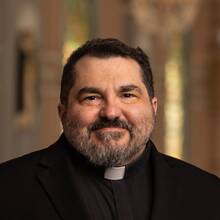Does your life invite others to share in God's presence?
The distinctive beliefs of ancient Israel were rooted in ancient Near Eastern culture. The gods in this culture were “fluid” beings that could “distribute” themselves. In a way that some scholars compare to the Catholic “real presence,” gods could appear in many places and many forms simultaneously, without ever exhausting their power or individuality. Just as Catholics understand the eucharistic host to be entirely Christ without being the entirety of Christ, ancient Near Eastern worshippers understood their gods to be fully present in a variety of forms and places without ever limiting their individuality. Deities could “fragment” and appear in multiple temples and in celestial phenomena simultaneously, and they could “overlap” with statues, priests or prophets and render them temporarily a place where one could encounter the divine.
‘Go, therefore, and make disciples of all nations, baptizing them in the name of the Father, and of the Son, and of the Holy Spirit.’ (Mt 28:19)
How have you encountered the divine presence?
How does your life invite others to share God’s nature?
Certain passages in the Old Testament show that Israel shared these beliefs. The patriarchs built shrines wherever they encountered a divine “fragment,” as Jacob did at Bethel, for example (Gn 28:20-22). Furthermore, God could “overlap” with human beings to accomplish divine goals. Moses, Elijah and Elisha so consistently fulfilled the divine will that that Scripture calls each a “man of God.” Later royal and priestly scribes who transmitted these narratives often downplayed traditions of distributed divine presence, fearing the idolatry they might inspire.
These traditions made a vigorous comeback in apocalyptic writings of the last centuries before Christ. Primary among these is Dn 7:13-14, which describes God granting a full share of his power and glory to “one like a son of man.” Several literary clues connect this Sunday’s Gospel reading with this passage. The earliest Semitic Christians believed Jesus to be the fulfillment of this passage. His divine sharing was so complete that he even outranked Moses and Elijah as a “man of God.” He was the “Son of God,” as the baptism and transfiguration narratives attest. Christians furthermore proclaimed that anyone could join Christ as a child of God if only they accepted his Spirit in baptism and followed his teachings, as the Gospel and second reading this Sunday affirm.
Greek Christians struggled to understand this tradition. Luke wrote the Book of Acts, in part, to explain to his Greek audience the effects of divine “overlap.” God’s Spirit transformed individual Christians like Stephen and Paul, while the Spirit’s presence in the Christian community made it an ongoing manifestation of God’s presence on earth (Acts 2:42-47). The Trinitarian controversies of Christianity’s first centuries represent the efforts of Greek scholars to understand how divinity could be distributed first among Father, Son and Spirit, and then among the Son’s disciples, who continued his mission.
We are God’s distributed bodies today. Our doctrine of the Trinity teaches that God wants to share his nature with us. When we live and love as the Gospel teaches, we reveal ourselves to be points of overlap between the heavenly and earthly realms. Staying close to the Gospel is no easy task; it will take most of us a lifetime of conversion and hope. The result, however, is that through us, others may hear God’s invitation to share the divine nature. Like the great saints, we will become bearers of the glory of God.
This article also appeared in print, under the headline “Ever Ancient, Ever New,” in the May 14, 2018, issue.








